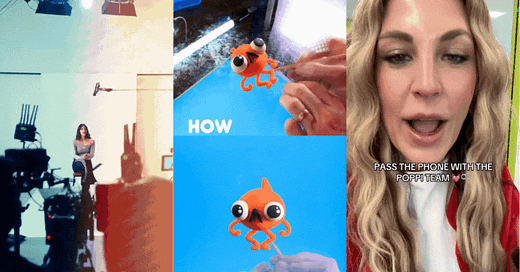Silence, Brand! Deep Dive: How our content innovations design their own obsolescence
🦀 Defining "CAPTCHA Content" and its role on a dying internet
Over the past few months, more creators and brands have pulled back the curtain to show you how the sausage is made (and who’s making it):
Beauty and fashion brands like Glossier and Adidas are posting behind-the-scenes (BTS) content of photoshoots
Employee-generated content (EGC) has become a mainstay for brands like Poppi and Spencer’s, turning their teams into on-screen talent
Streaming services are revealing how they captured iconic shots in shows like Apple TV’s The Studio or Netflix’s Squid Games
Creators from all industries are breaking the fourth wall to take viewers inside their art process
This supplementary content has become the main event, rivalling and—in the case of claymation animator @bigwhoop.animation—even outperforming the original posts.

What is “CAPTCHA Content”?
Although the marketing industry has been fetishising the elusive, ultimately unattainable quality of “authenticity” in content for years, recent advancements in the capability and accessibility of generative AI models have rapidly polluted the internet with AI slop and created widespread cultural demand for content that is genuinely authentic (read: human-made).
Styles of content like BTS and EGC are familiar, but over the past several months, they’ve acquired a certain social function as “proof of humanity,” defining a macrogenre I’m calling CAPTCHA Content for two reasons.
The first is perhaps self-explanatory, CAPTCHA (or Completely Automated Public Turing Test to tell Computers and Humans Apart) has been the standard for distinguishing between humans and robots on the internet for decades. Formats like BTS and EGC are social media’s equivalent of clicking “I’m not a robot.” That is, for now.
Which brings us to the second, perhaps less obvious, reason.
CAPTCHA Designs Its Own Obsolescence
Those log-in puzzles aren’t random; they’re specific to whatever machine-learning model is in development. The data collected from humans trying to access their Gmail is used by tech companies to train their AI models, meaning CAPTCHA is only ever one step ahead of the robots it discriminates against.
Think back to the early internet when you’d have to type out a set of squiggly or obstructed characters. Now we practically expect that any AI can read our sloppy handwriting or make sense of a poorly scanned textbook. Frustrated that you’ve been selecting all those crosswalks, bicycles and fire hydrants for the past decade? Congrats! The fruits of your labour (self-driving cars) can now be found everywhere.
CAPTCHA Content only acts as proof of humanity until AI can sufficiently replicate it. As with AI’s infiltration into our world writ large, this will happen far sooner than most of us are willing to admit.
Currently, AI-generated video on social largely amounts to uncanny spectacle that quickly becomes fatiguing. But it requires a hefty amount of mental gymnastics to watch AI emulate familiar content creation formats or fake ad spots, regardless of how ridiculous and unsettling they might be, and believe that convincing, robot-produced short-form content is more than a year away.
Capitalising on the growing desire for this certification of humanity, creators and brands will produce more CAPTCHA content, providing a larger dataset for companies to train models (such as Google’s Veo 3) to replicate this content in increasingly life-like ways. At that point, CAPTCHA content, as we know it today, will cease to separate human creativity from robot junk.
At present, posts expressing concern surrounding AI slop are louder and more numerous than the slop itself. For marketers, this means we’re only going to see more CAPTCHA content (and more engagement on it) as a large chunk of brand loyalty becomes determined by a company’s public stance on AI.
wrote an excellent article on how brands are turning this content into social media capital.
Marketing the Dead Internet
However, as AI slop pollutes the internet, we’ve also seen a lot more references to the “dead internet theory.” A decade ago, the idea that the majority of digital content online is AI-generated, much less due to an intentional and malicious effort, was laughable. Now, a “dead internet” where human-made content becomes the minority is not only feasible but inevitable.
Jean Baudrillard’s hyperreality theory, originally coined in 1981, provides the basis for this grim forecast. There’s a fascinating paper by Thomas Sommerer published in April that applies Baudrillard’s perspective in the context of AI slop and the social internet:
Just as Baudrillard saw it coming with media, the dead internet, cutting out the human element, is the perfect example of a system that was built to represent symbolic meaning, but by transferring it into binary code and sign value, it has proliferated into a sphere of its own, leaving its source origin behind.
(Sommerer, 2025)
This is the logical endpoint of an internet where media is stripped from its context and artificially “memed” beyond any sense of meaning or traceable origin. Our posts are used to train bots to produce increasingly robust simulations of human creativity that will then be used to train other bots ad infinitum, eventually removing humanity from the equation altogether.
It’s the final stage of commodifying the social internet. We’re headed right for it, and there are no signs of slowing down.
None with any meaning, at least. [Benton Williams]
Silence, Brand! is an internet culture and marketing newsletter compiled by unhinged brand marketing professionals—an elite army of internet idiots.
Thank you to this installment’s contributors: Benton Williams and Dayna Castillo








